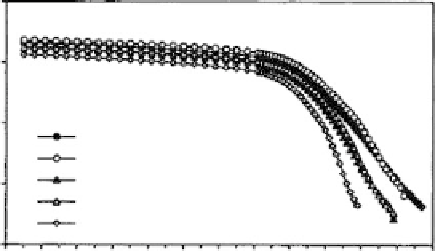Biomedical Engineering Reference
In-Depth Information
from the 0.5-0.75 MPa range to the 1.25-1.5 MPa range when untreated CNXLs were
added in PDMS. Surprisingly, trimethylsilylation of the CNXLs lowered the reinforcing
effect of CNXLs on PDMS, a phenomenon that was ascribed to surface hydrophobicity
(72). A similar approach was taken with cellulose acetate butyrate (CAB) matrix (73).
Partially silylated (DS of 0.49) and untreated CNXLs were incorporated into CAB at var-
ious loadings from 2% to 10 wt%. Although a small increase in the melting temperature
of the CAB was reported with higher CNXL content, its crystallinity slightly decreased
in presence of silylated or untreated CNXLs. CNXLS were proposed to impinge on
CAB crystallization. As expected, the nanocomposite storage modulus increased with
higher CNXLs content and above the glass transition temperature of CAB, the sily-
lated CNXLs provided a less efficient reinforcement than the native CNXLs (73), a
phenomenon similar to that observed with PDMS (72) (Figure 9.30).
Damping was
also reduced in presence of CNXLs.
It was thus proposed that on a weight basis the
10,000
1000
100
10 wt.% Silyalted crystals
10 wt.% Native crystals
5 wt.% Silylated crystals
5 wt.% Native crystals
0 wt.% crystals
10
1
25
35
45
55
65 75
Temperature (
85
95
105 115 125 135 145
°
C)
1.6
10 wt.% Silylated crystals
10 wt.% Native crystals
5 wt.% Silylated crystals
5 wt.% Native crystals
0 wt.% crystals
1.4
1.2
1
0.8
0.6
0.4
0.2
0
25
35
45
55
65 75
Temperature (
85
95
105 115 125 135 145
C)
°
Figure 9.30
Temperature dependence of the storage modulus (E') and loss tangent (tan
d) of the composites at a frequency of 10 Hz.
(With kind permission from Springer
Science
Business Media: Journal of Polymers and the Environment, Nanocomposites
of cellulose acetate butyrate reinforced with cellulose nanocrystals, 10, 2002, 27-30,
M.GrunertandWinter,W.T.,Figure4.)
+


Search WWH ::

Custom Search